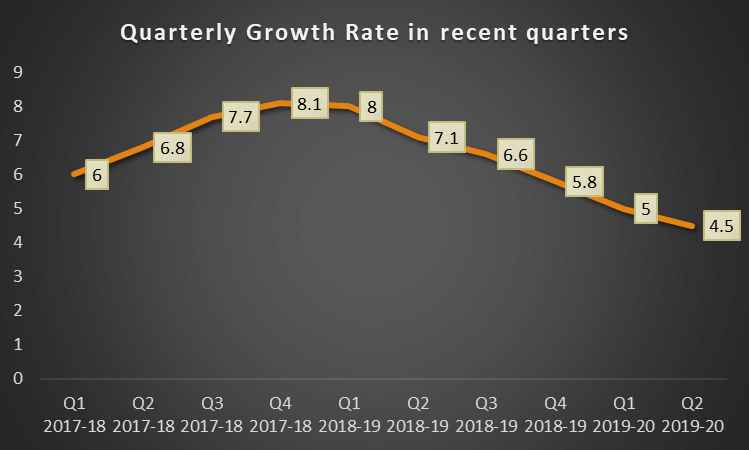With high inflation appearing in the background of slowing economic growth, economists are suddenly warning about stagflation threat for Indian economy.
Growth-inflation combination gives stagflation fearsGDP growth rate is at six-and-a-half-year low at 4.5%. Inflation rate is at the five and a half year high at 7.35%. |
The latest macro data on prices showed inflation crossing 7.35% during December 2019 from a moderate 5.5% in the previous month.
Inflation now registered the five and a half year high whereas GDP growth rate (quarterly) registered the lowest in six and a half year low.

Though the price rise is due to an increase in food prices that is now a past event, economists are eager to predict the possibility of a strange macroeconomic situation called stagflation.

What is stagflation?
Stagflation is a strange combination of stagnation (low economic growth) and high inflation. High unemployment and other related negative effects of low economic growth usually come along stagflation.
| Stagnation = Stagnation + Inflation |
The situation is strange because traditional macroeconomic theory says that inflation appears along with high economic growth and not with poor economic performance.
Inflation is said to be a symptom of economic growth. On the other hand, deflation comes along with low economic growth.
But in the 1960s, inflation occurred with low economic growth phase.
This has created big challenges to policy makers. Traditionally, expansionary policies (tax cuts and higher government expenditure) were used comfortably to fight low growth- deflation combination whereas contractionary policies (taxation and reduced expenditure) were used to fight high growth- inflation situation.
But what can do if the unlikely combination of low growth and inflation comes?
Difficulty of fighting low economic growth and inflation simultaneously
The unlikely combination of inflation and stagnation poses threats to policy makers. This is because conventionally, higher expenditure and money supply expansion are used to overcome low economic growth.
But when this low growth comes with inflation, expansion in expenditure and money supply to promote growth will further worsen inflation. One medicine adversely affects the other disease.
Stagflation is often attributed to slowdown coming from low investment, poor demand, reduced consumption and fall in GDP growth whereas there is rise in prices in key products and sectors.
Is stagflation hitting the Indian Economy?
Policy makers are predicting stagflation as the December 2019 retail inflation figure jumped 7.35%. Already India is experiencing fall in GDP growth in the background of several adverse factors.
Of course, high inflation happened after a long time. So far over the last five years, prices were at comfortable level with an average 4% growth. This is good for the RBI’s monetary policy as the target is 4%.
In this context, the newly appeared 7.35% inflation figure is uncomfortable. At the same time, there is no certainty that this inflation will stay there at high levels because the origin of the inflation is due to supply shock in food materials.
The possibility of stagflation depends heavily on the other factor that may bring inflation – crude price. Usually, food prices are fluctuating. This month the price may be higher, but in the next month normalcy may be restored.
But fuel price is a factor that is outside our control. If the Middle East tension maintains high crude prices, it may keep the inflation rate high. Such a trend will be more dangerous compared to the food inflation as the crude prices have higher ability to spread into other sectors like manufacturing.
Hence, the possibility of stagflation depends upon crude prices more than on food prices. The current monthly trend is not warranting stagflation as far as fuel prices go at a manageable level.
*********









